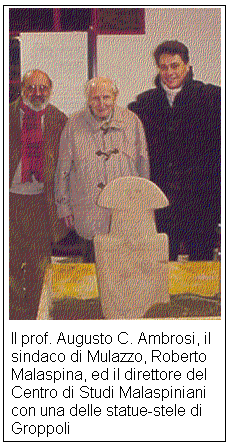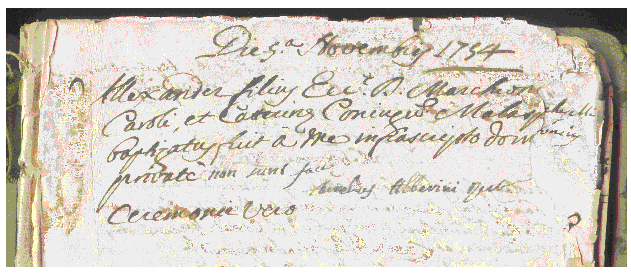CENTRO DI STUDI MALASPINIANI
“ALESSANDRO MALASPINA"
Mulazzo, Massa-Carrara, Italia
NEWSLETTER OF THE CENTRO
Year 2, no. 1
January 10/2001
Edited by Dario Manfredi, translated by John Black
NEWS

1. - The first news of this new year concerns not Alexandro
Malaspina but rather the territory of Mulazzo. Taking advantage
of a rather exceptional event, we seize the opportunity to bring it to
the attention of everyone interested in both the Navigator and the land
in which he was born.
In the vicinity of Stallone di Groppoli two
statue-stele have been unearthed. It is reported that the finds derive
from the Bronze Age (2nd millennium B.C.). The stelae are both female,
and one of the two is headless, having apparenty been the victim of the
iconoclastic frenzy which invested the Vale of Magra between the Bronze
Age and the Iron Age. These are not the first statue-stele to be
discovered within the Commune of Mulazzo (previously one had been discovered
at Campoli and two at Canossa), but the discovery confirms the hypothesis
that in prehistory, along the right bank of the Magra, there were numerous
settlements perhaps not inferior to those on the opposite bank.
The two statue-stele, after the necessary
restoration, will be kept in the Museo del Piagnaro (Pontremoli), which
(between originals and casts) already contains more than fifty of them.
2. - Blanca Sáiz and Dario Manfredi are working on an updating
of the bibliography relating to Alexandro Malaspina and his scientific
expedition. The only existing bibliography on Malaspina, compiled
by Blanca Sáiz, goes up to 1992 and comprises more than 1100 entries.
Even so, since then there have appeared over 500 more works, mostly in
Spain, but also in Italy and in America. If it proves difficult to
find a motivated publisher, the compilers are planning to put the work
on-line, which will no doubt be particularly helpful for researchers.
3. - A useful collaboration (exchange of publications etc.) has been
set up between this Centro and the Istituto Geografico Polare Silvio Zavatti
di Fermo. Anyone interested in knowing more about the activity of
this institute can send e-mail to Gianluca Frinchillucci, its director:
gfrinc@hotmail.com.
PUBLISHING NOTES AND COMMENTS
E. SOLER PASCUAL, «La utopía de Robinson Malaspina»,
Contextos, Valencia, s.d., Grupo 10 Librerias de Calidad, pp. 37-58.
This slim volume includes a dozen literary
compositions of various kinds. Emilio Soler (whom Malaspinisti know
well as having published some groundbreaking work on the arrest of Malaspina)
has for once abandoned history to devote himself to literary creation.
This consists in fact of a short story in which the Navigator, during the
Expedition, reaches the islands of Juan Fernández, fakes his own
tragic disappearance and, taking refuge in the cave previously occupied
by Robinson Crusoe, tries to reach the state of happiness that in old Europe
was regarded as utopian.
The novella is well-written and absorbing,
confirming that Emilio Soler knows also how to be a pleasing writer; in
this "fabulous" context there also appear some absolutely fantastical
incidental references: Mulazzo belonging to the Duchy of Parma, Félix
de Azara and the Count of Floridablanca schoolmates
of Malaspina, the departure took place on July 1/1789...
OUR LIBRARY
Latest publications to reach the Center
Il Polo. Rivista trimestrale dell'Istituto Geografico Polare
Silvio Zavatti, Anno LV, vol. 1, March 2000.
This magazine also contains facsimile reproductions
of the 1945-46 editions of the "Bollettino dell'Istituto Geografico Polare,"
with interesting articles on the Nobile expedition to the North Pole.
PEDANT'S CORNER
In the final news-bulletin of last year we
addressed the year of death of Alexandro Malaspina. We now want to speak
of his birth, for two reasons: there is no shortage of people who still
maintain, first of all, that the Navigator was born in Milazzo (Sicily),
and second (confusing him with his older brother) that he was born in 1749.
To put an end once and for all to this quarrel, we publish here Paper 279
of the Register of Baptisms (1689-1806) of the Parish of Mulazzo, in which
appears the record regarding Alexandro.
 The document (belonging to the Parish Archives of Mulazzo, but kept at
the Centro
di Studi Malaspiniani) is not very well-preserved, so we thought it
useful to give its transcription too:
The document (belonging to the Parish Archives of Mulazzo, but kept at
the Centro
di Studi Malaspiniani) is not very well-preserved, so we thought it
useful to give its transcription too:
Dies 5a Novembris 1754
Alexander filius Ecc.i D. Marchionis Caroli,
et Caterina Coniuges Malaspina, baptizatus fuit a me infrascripto domi
private.
Ceremonie vero non sunt facte (1)
Aurelius Alberini
Rect.
______
1) The last four words appear to be a later addition.
Return to AMRC Homepage
Italian Original

